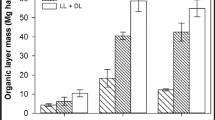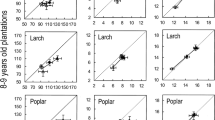Abstract
Pinus plantations have increased in Brazil, and native forest areas have been converted for timber production. The clearing and the long-term loblolly pine (Pinus taeda L.) land-use effects on soil carbon and nitrogen stocks were evaluated in a natural broadleaved forest and in loblolly pine sites cultivated for 29, 35, 38 and 49 years, as well the soil contribution as ecosystem carbon pool. According to the exponential-decay model fitted to changes in carbon stock, the initial soil carbon stock of 200 Mg ha−1 to a depth of 100 cm in the natural forest decreased by 36% over 49 years of pine cultivation (around 72.4 Mg ha−1 of C). Around two-thirds of this decrease occurred in the top 30 cm of the soil and intensively in the first 12 years of cultivation, but slowly faded as carbon stock tended to reach a new steady state after approximately 49 years of cultivation. The soil nitrogen stock in the natural forest was 14.2 Mg ha−1 to a depth of 100 cm and decreased by 36% over the 49 years. This decrease was linear according to the fitted model, especially in the top 30 cm where nitrogen decline was 83% and was proportionally more intense than the carbon decline. Despite the soil carbon decrease, soil remained the largest carbon reservoir in the ecosystem for the growing rotation time of loblolly pine in this region.





Similar content being viewed by others
References
Alvares CA, Stape JL, Sentelhas PC, Gonçalves JLM, Sparovek G (2013) Köppen’s climate classification map for Brazil. Meteorol Z 6:711–728
Baldock JA, Broos K (2012) Soil organic matter. In: Huang PM, Li Y, Sumner ME (eds.) Hanbook of Soil Sciences: Properties and Processes. CRC Press, Boca Raton, pp. 12.11–12.23
Balesdent J, Chenu C, Balabane M (2000) Relationship of soil organic matter dynamics to physical protection and tillage. Soil till Res 53:215–230. https://doi.org/10.1016/S0167-1987(99)00107-5
Bates D, Maechler M, Bolker B (2015) Fitting linear mixed-effects models using lme4. J Stat Softw 67:1–48
Blake GR, Hartge KH (1986) Bulk density. In: Klute A (ed.) Methods of Soil Analysis: Part 1. Physical and Minerological Methods. SSSA, Madison, pp. 363–382
Britez RM, Borgo M, Tiepolo G, Ferretti A, Calmon M, Higa R (2006) Estoque e incremento de carbono em florestas e povoamentos de espécies arbóreas com ênfase na Floresta Atlântica do Sul do Brasil. Embrapa Florestas, Colombo
Cardoso DJ, Garrastazú MC, Lacerda AEB, Fiorucci LH, Zanatta JA, Higa RCV, Rachwal MFG (2018) Estoque de biomassa arbórea em remanescentes de Floresta Ombrófila Mista e área de transição: inferências sobre estágio sucessional. Embrapa Florestas, Colombo
Chen GS, Yang YS, **e JS, Guo JF, Gao R, Qian W (2005) Conversion of a natural broad-leafed evergreen forest into pure plantation forests in a subtropical area: Effects on carbon storage. Ann for Sci 62:659–668. https://doi.org/10.1051/forest:2005073
Chen GS, Yang ZJ, Gao R, **e JS, Guo JF, Huang ZQ, Yang YS (2013) Carbon storage in a chronosequence of Chinese fir plantations in southern China. For Ecol Manage 300:68–76. https://doi.org/10.1016/j.foreco.2012.07.046
Chen GS, Yang YS, Yang ZJ, **e JS, Guo JF, Gao R, Yin YF, Robinson D (2016) Accelerated soil carbon turnover under tree plantations limits soil carbon storage. Sci Rep 6:1–7. https://doi.org/10.1038/srep19693
Chen LC, Wang H, Yu X, Zhang WD, Lu XT, Wang SL (2017) Recovery time of soil carbon pools of conversional Chinese fir plantations from broadleaved forests in subtropical regions. China Sci Total Environ 587:296–304. https://doi.org/10.1016/j.scitotenv.2017.02.140
FAO (2015) Global Forest Resources Assessment 2015: How are the world’s forests changing?, 2nd edn. FAO, Rome
Figueiredo Filho A, Machado AS, Miranda ROV, Retslaff FAS (2014) Compêndio de Equações de Volume e de Afilamento de Espécies Florestais. UFV, Viçosa
Finger CAG (1992) Fundamentos de biometria florestal. UFSM/CEPEF/FATEC, Santa Maria
Guo LB, Gifford RM (2002) Soil carbon stocks and land use change: a meta analysis. Glob Change Biol 8:345–360. https://doi.org/10.1046/j.1354-1013.2002.00486.x
Higa RCV (2005) Dinâmica de carbono de Pinus taeda L. voltadas a exigências climáticas e práticas silviculturais. Post doctoral, University of Florida
Higa RCV, Cardoso DJ, Andrade GC, Zanatta JA, Rossi LMB, Pulrolnik K, Nicodemo MLF, Garrastazú MC, Vasconcelos SS, Salis SM (2014) Protocolo de medição e estimativa de biomassa e carbono florestal. Embrapa Florestas, Colombo
Hulbert SH (1984) Pseudoreplication and the design of ecological field experiments. Ecol Monogr 54:187–211. https://doi.org/10.2307/1942661
IBÁ (2019). Report 2019. IBÁ
IBÁ (2020). Annual Report 2020. IBÁ
IBGE (2018) Produção da Extração Vegetal e da Silvicultura 2018 - PEVS. Prod Extr Veg Silvic 33:1–8
Intergovernmental Panel on Climate Change (IPCC) (2006) 2006 IPCC Guidelines for National Greenhouse Gas Inventories. Eggleston HS, Buendia L, Miwa K, Ngara T, Tanabe K (eds). Prepared by the National Greenhouse Gas Inventories Programme. IGES, Japan
IUSS Working Group WRB (2015) World Reference Base for Soil Resources 2014, update 2015: International soil classification system for naming soils and creating legends for soil maps. FAO, Rome
James J, Harrison R (2016) The effect of harvest on forest soil carbon: a meta-analysis. Forests 308:1–22. https://doi.org/10.3390/f7120308
Jandl R, Lindner M, Vesterdal L, Bauwens B, Baritz R, Hagedorn F, Johnson DW, Minkkinen K, Byrne KA (2007) How strongly can forest management influence soil carbon sequestration? Geoderma 137:253–268. https://doi.org/10.1016/j.geoderma.2006.09.003
Krishna MP, Mohan M (2017) Litter decomposition in forest ecosystems: a review. Energy, Ecology and Environment 2:236–249. https://doi.org/10.1007/s40974-017-0064-9
Lal R (2005) Forest soils and carbon sequestration. For Ecol Manage 220:242–258. https://doi.org/10.1016/j.foreco.2005.08.015
Li S, Su J, Liu W, Lang X, Huang X, Jia C, Zhang Z, Tong Q (2015) Changes in Biomass Carbon and Soil Organic Carbon Stocks following the Conversion from a Secondary Coniferous Forest to a Pine Plantation. PLoS ONE 10:1–14. https://doi.org/10.1371/journal.pone.0135946
Liao CZ, Luo YQ, Fang CM, Chen JK, Li B (2012) The effects of plantation practice on soil properties based on the comparison between natural and planted forests: a meta-analysis. Global Ecolo Biogeogr 21:318–327. https://doi.org/10.1111/j.1466-8238.2011.00690.x
Mafra ÁL, Guedes SFF, Klauberg Filho O, Santos JCP, Almeida JA, Rosa JD (2008) Carbono orgânico e atributos químicos do solo em áreas florestais. Rev Árvore 32:217–224. https://doi.org/10.1590/S0100-67622008000200004
McEwan A, Marchi E, Spinelli R, Brink M (2020) Past, present and future of industrial plantation forestry and implication on future timber harvesting technology. J for Res 31:339–351. https://doi.org/10.1007/s11676-019-01019-3
Mineropar (2001) Atlas Geológico do Estado do Paraná. Mineropar, Curitiba
Mokany K, Raison RJ, Prokushkin AS (2006) Critical analysis of root:shoot ratios in terrestrial biomes. Glob Change Biol 12:84–96. https://doi.org/10.1111/j.1365-2486.2005.001043.x
Nepal P, Korhonen J, Prestemon JP, Cubbage FW (2019) Projecting global planted forest area developments and the associated impacts on global forest product markets. J Environ Manage 240:421–430. https://doi.org/10.1016/j.jenvman.2019.03.126
Payn T, Carnus JM, Freer-Smith P, Kimberley M, Kollert W, Liu SR, Orazio C, Rodriguez L, Silva LN, Wingfield MJ (2015) Changes in planted forests and future global implications. For Ecol Manage 352:57–67. https://doi.org/10.1016/j.foreco.2015.06.021
Sanquetta CR, Corte APD, Silva F (2011) Biomass expansion factor and root-to-shoot ratio for Pinus in Brazil. Carbon Bal Manage 6:1–6. https://doi.org/10.1186/1750-0680-6-6
Santos HG, Jacomine PKT, Anjos LHC, Oliveira VÁ, Lumbreras JF, Coelho MR, Almeida JA, Filho JCA, Oliveira JB, Cunha TJF (2018) Sistema Brasileiro de Classificação de Solos. Embrapa, Brasília
Schumacher FX, Hall FS (1933) Logarithmic expression of timber-tree volume. J Agric Res 47:719–734
Sette Junior CR, Nakajima NY, Geromini MP (2006) Captura de carbono orgânico em povoamentos de Pinus taeda L. na região de Rio Negrinho. SC Floresta 36:33–44. https://doi.org/10.5380/rf.v36i1.5506
Sisti CPJ, Santos HP, Kohhann R, Alves BJR, Urquiaga S, Boddey RM (2004) Change in carbon and nitrogen stocks in soil under 13 years of conventional or zero tillage in southern Brazil. Soil Tillage Res 76:39–58. https://doi.org/10.1016/j.still.2003.08.007
Turner J, Lambert M (2000) Change in organic carbon in forest plantation soils in eastern Australia. For Ecol Manage 133:231–247. https://doi.org/10.1016/S0378-1127(99)00236-4
Veloso MG, Dieckow J, Zanatta JA, Bayer C, Higa RCV, Brevilieri RC, Comerford NB, Stoppe AM (2018) Reforestation with loblolly pine can restore the initial soil carbon stock relative to a subtropical natural forest after 30 years. Eur J for Res 137:593–604. https://doi.org/10.1007/s10342-018-1127-y
Vogelmann ES, Prevedello J, Reichert JM (2015) Origem dos compostos hidrofóbicos e seus efeitos em florestas de Pinus e Eucalyptus. Ci Fl 25:1067–1079. https://doi.org/10.5902/1980509820670
von Lützow M, Kögel-Knabner I, Ekschmitt K, Matzner E, Guggenberger G, Marschner B, Flessa H (2006) Stabilization of organic matter in temperate soils: mechanisms and their relevance under different soil conditions - a review. Eur J Soil Sci 57:426–445. https://doi.org/10.1111/j.1365-2389.2006.00809.x
Wang JL, Wang HM, Fu XL, Xu MJ, Wang YD (2016) Effects of site preparation treatments before afforestation on soil carbon release. For Ecol Manage 361:277–285. https://doi.org/10.1016/j.foreco.2015.11.022
Wiesmeier M, Dick DP, Rumpel C, Dalmolin RSD, Hilscher A, Knicker H (2009) Depletion of soil organic carbon and nitrogen under Pinus taeda plantations in Southern Brazilian grasslands (Campos). Eur J Soil Sci 60:347–359. https://doi.org/10.1111/j.1365-2389.2009.01119.x
Wrege MS, Steinmetz S, Júnior CR, Almeida IR (2012) Atlas climático da Região Sul do Brasil: Estados do Paraná, Santa Catarina e Rio Grande do Sul. Embrapa, Brasilia
Zheng H, Ouyang ZY, Xu WH, Wang XK, Miao H, Li XQ, Tian YX (2008) Variation of carbon storage by different reforestation types in the hilly red soil region of southern China. For Ecol Manage 255:1113–1121. https://doi.org/10.1016/j.foreco.2007.10.015
Zhu X, Lin J, Dai Q, Xu YY, Li HD (2019) Evaluation of Forest Conversion Effects on Soil Erosion, Soil Organic Carbon and Total Nitrogen Based on Cs-137 Tracer Technique. Forests 10:1–14. https://doi.org/10.3390/f10050433
Acknowledgements
We would like to thank the National Council for Scientific and Technological Development for their financial support (Edital Universal), Embrapa (Projeto Saltus) and scholarships; the Coordination for the Improvement of Higher Education Personnel for financial support; R. C. Brevilieri and P. L. Simon for technical support in field and laboratory; W. A. Holler for technical support for the map production.
Author information
Authors and Affiliations
Corresponding author
Additional information
Communicated by Miren del Rio.
Publisher's Note
Springer Nature remains neutral with regard to jurisdictional claims in published maps and institutional affiliations.
Supplementary Information
Below is the link to the electronic supplementary material.
Rights and permissions
About this article
Cite this article
Ibarr, M.A., Zanatta, J.A., Dieckow, J. et al. Changes in soil carbon and nitrogen stocks after conversion of subtropical natural forest to loblolly pine plantations. Eur J Forest Res 141, 31–42 (2022). https://doi.org/10.1007/s10342-021-01424-6
Received:
Revised:
Accepted:
Published:
Issue Date:
DOI: https://doi.org/10.1007/s10342-021-01424-6




